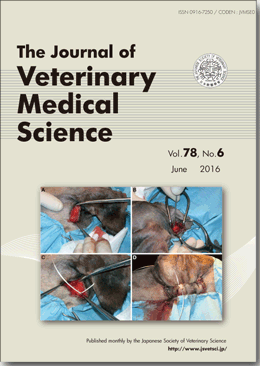Volume 78, Issue 6
June
Displaying 1-27 of 27 articles from this issue
- |<
- <
- 1
- >
- >|
Anatomy
-
2016Volume 78Issue 6 Pages 957-962
Published: 2016
Released on J-STAGE: July 01, 2016
Advance online publication: February 15, 2016Download PDF (1445K)
Biochemistry
-
2016Volume 78Issue 6 Pages 943-949
Published: 2016
Released on J-STAGE: July 01, 2016
Advance online publication: February 18, 2016Download PDF (893K) -
2016Volume 78Issue 6 Pages 987-995
Published: 2016
Released on J-STAGE: July 01, 2016
Advance online publication: February 26, 2016Download PDF (1972K)
Clinical Pathology
-
2016Volume 78Issue 6 Pages 1051-1054
Published: 2016
Released on J-STAGE: July 01, 2016
Advance online publication: February 22, 2016Download PDF (543K)
Internal Medicine
-
2016Volume 78Issue 6 Pages 1079-1083
Published: 2016
Released on J-STAGE: July 01, 2016
Advance online publication: March 14, 2016Download PDF (421K)
Laboratory Animal Science
-
2016Volume 78Issue 6 Pages 951-956
Published: 2016
Released on J-STAGE: July 01, 2016
Advance online publication: February 19, 2016Download PDF (456K) -
2016Volume 78Issue 6 Pages 1045-1050
Published: 2016
Released on J-STAGE: July 01, 2016
Advance online publication: February 20, 2016Download PDF (1229K)
Pathology
-
2016Volume 78Issue 6 Pages 937-942
Published: 2016
Released on J-STAGE: July 01, 2016
Advance online publication: February 18, 2016Download PDF (1562K) -
2016Volume 78Issue 6 Pages 997-1006
Published: 2016
Released on J-STAGE: July 01, 2016
Advance online publication: February 27, 2016Download PDF (2809K) -
2016Volume 78Issue 6 Pages 1039-1043
Published: 2016
Released on J-STAGE: July 01, 2016
Advance online publication: February 18, 2016Download PDF (2477K) -
2016Volume 78Issue 6 Pages 1063-1066
Published: 2016
Released on J-STAGE: July 01, 2016
Advance online publication: March 09, 2016Download PDF (1888K) -
2016Volume 78Issue 6 Pages 1075-1078
Published: 2016
Released on J-STAGE: July 01, 2016
Advance online publication: March 04, 2016Download PDF (2777K) -
2016Volume 78Issue 6 Pages 1085-1088
Published: 2016
Released on J-STAGE: July 01, 2016
Advance online publication: March 13, 2016Download PDF (1785K)
Pharmacology
-
2016Volume 78Issue 6 Pages 1025-1029
Published: 2016
Released on J-STAGE: July 01, 2016
Advance online publication: March 24, 2016Download PDF (477K)
Physiology
-
2016Volume 78Issue 6 Pages 921-928
Published: 2016
Released on J-STAGE: July 01, 2016
Advance online publication: February 11, 2016Download PDF (895K) -
2016Volume 78Issue 6 Pages 977-985
Published: 2016
Released on J-STAGE: July 01, 2016
Advance online publication: February 26, 2016Download PDF (1311K)
Public Health
-
2016Volume 78Issue 6 Pages 1035-1038
Published: 2016
Released on J-STAGE: July 01, 2016
Advance online publication: February 14, 2016Download PDF (629K)
Surgery
-
2016Volume 78Issue 6 Pages 929-936
Published: 2016
Released on J-STAGE: July 01, 2016
Advance online publication: February 11, 2016Download PDF (504K) -
2016Volume 78Issue 6 Pages 963-970
Published: 2016
Released on J-STAGE: July 01, 2016
Advance online publication: February 28, 2016Download PDF (1151K) -
2016Volume 78Issue 6 Pages 1031-1034
Published: 2016
Released on J-STAGE: July 01, 2016
Advance online publication: February 11, 2016Download PDF (435K)
Theriogenology
-
2016Volume 78Issue 6 Pages 1019-1023
Published: 2016
Released on J-STAGE: July 01, 2016
Advance online publication: March 04, 2016Download PDF (517K) -
2016Volume 78Issue 6 Pages 1067-1073
Published: 2016
Released on J-STAGE: July 01, 2016
Advance online publication: March 03, 2016Download PDF (1194K)
Virology
-
2016Volume 78Issue 6 Pages 1013-1017
Published: 2016
Released on J-STAGE: July 01, 2016
Advance online publication: March 03, 2016Download PDF (621K) -
2016Volume 78Issue 6 Pages 1059-1061
Published: 2016
Released on J-STAGE: July 01, 2016
Advance online publication: February 27, 2016Download PDF (620K)
Wildlife Science
-
2016Volume 78Issue 6 Pages 971-976
Published: 2016
Released on J-STAGE: July 01, 2016
Advance online publication: February 22, 2016Download PDF (907K) -
2016Volume 78Issue 6 Pages 1007-1011
Published: 2016
Released on J-STAGE: July 01, 2016
Advance online publication: March 17, 2016Download PDF (889K) -
2016Volume 78Issue 6 Pages 1055-1058
Published: 2016
Released on J-STAGE: July 01, 2016
Advance online publication: February 26, 2016Download PDF (740K)
- |<
- <
- 1
- >
- >|
